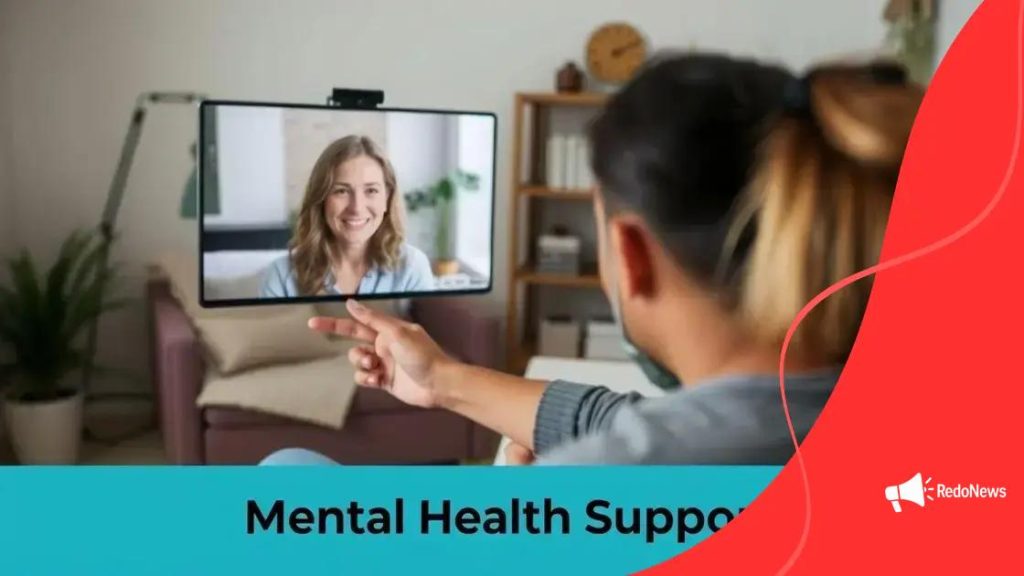Tele-mental health: Access expands for everyone

Tele-mental health utilizes technology to connect clients with therapists remotely, offering benefits like increased accessibility, convenience, and privacy, while also addressing challenges such as technology reliance and maintaining effectiveness.
Tele-mental health is changing the landscape of mental health care, making it more accessible than ever. Have you wondered how this shift affects your options for support?
Understanding tele-mental health
Understanding tele-mental health is vital in today’s digital age. It refers to providing mental health resources through technology. This approach allows individuals to access support without visiting a therapist in person.
As we explore this topic, consider how convenient it is to receive care from your home. With just a few clicks, you can connect with qualified professionals ready to help. This method not only saves time but also reduces the barrier to accessing mental health services.
How does tele-mental health work?
Tele-mental health utilizes various platforms such as video calls, phone conversations, and messaging. This flexibility means that you can engage in therapy during a lunch break, after work, or even while traveling.
Benefits of this approach include:
- Increased accessibility for individuals in remote areas.
- More flexible scheduling to fit busy routines.
- Heightened privacy and comfort in familiar environments.
Furthermore, research shows that tele-mental health can be just as effective as traditional in-person visits. Many clients report feeling more at ease discussing their issues from home, which can lead to more open conversations and better outcomes.
The expansion of tele-mental health is an exciting development. It opens doors for many who previously struggled to find suitable mental health care. As the technology continues to evolve, it may very well become a primary mode of delivery for mental health services.
Benefits of tele-mental health services
The benefits of tele-mental health services are numerous and significant for many individuals seeking support. For starters, this approach removes geographical barriers, allowing clients to connect with mental health professionals from anywhere. This is especially helpful for people who live in rural areas where access to specialists may be limited.
Moreover, tele-mental health offers flexibility in scheduling appointments. Clients can find times that fit their busy lives rather than being bound by traditional office hours. This can lead to more consistent attendance and better therapeutic outcomes.
Key advantages include:
- Enhanced privacy: Many individuals feel more comfortable discussing personal issues in their own space.
- Cost-effectiveness: Often, tele-mental health services are less expensive than in-person visits.
- Accessibility: Services can be tailored to suit different needs, including various formats like video, phone, or chat.
Furthermore, research suggests that the effectiveness of tele-mental health is comparable to traditional methods. Many clients report positive experiences, emphasizing that they felt just as connected to their therapist, which can lead to improved engagement in the therapeutic process.
As digital health continues to grow, more people are recognizing these benefits. With increased use of technology, seeking mental health support has never been easier or more convenient. The rise of tele-mental health marks a critical change in how mental health services are delivered and accessed, emphasizing the importance of making help available to everyone.
How tele-mental health works

Understanding how tele-mental health works is essential for anyone considering this modern approach to mental health care. At its core, it leverages technology to connect clients with therapists remotely. This eliminates the need for in-person visits and can significantly enhance accessibility.
Clients can engage in their sessions through various platforms like video conferencing, phone calls, or messaging. This flexibility allows individuals to choose the format they feel most comfortable with. Imagine being able to talk to a therapist while sitting at home or even while on the go.
Key components of tele-mental health include:
- Video conferencing: Many services use secure video calls to provide a face-to-face experience.
- Phone sessions: Clients can opt for traditional phone calls, which can feel more accessible.
- Text-based support: Some platforms offer chat options for those who prefer messaging.
Regardless of the method chosen, confidentiality remains a priority. Secure platforms ensure that all communications are protected, helping clients to feel safe and understood. Additionally, these digital tools often come with user-friendly interfaces, making it easy for anyone to navigate.
With tele-mental health, clients can schedule appointments that fit into their busy lives. The convenience of accessing therapy from home or any private space makes it easier for individuals to commit to their mental health journeys. This method not only reduces barriers but also enhances the overall therapeutic experience.
Challenges and considerations in tele-mental health
While there are many advantages to tele-mental health, there are also challenges and considerations that both clients and therapists must keep in mind. One major concern is the lack of face-to-face interaction. For some, the absence of in-person communication can lead to feelings of disconnect or difficulty in building rapport with the therapist.
Another challenge is the reliance on technology. Not everyone has reliable internet access or the necessary devices to participate in tele-mental health sessions. These barriers can prevent individuals from getting the help they need, especially in underserved communities.
Additional considerations include:
- Privacy and security: Ensuring that communication remains confidential is crucial for effective therapy.
- State regulations: Therapists must be aware of the licensing requirements that can vary by state.
- Technical issues: Problems like poor video quality or dropped connections can disrupt sessions.
Furthermore, it’s important for clients to be self-motivated and disciplined in scheduling sessions and engaging with their therapist. Without the structured environment of an office, some may struggle to maintain consistency in their therapy.
In summary, while tele-mental health can provide essential support, navigating these challenges is crucial for a positive and meaningful experience. Both clients and therapists should stay informed about the best practices and be prepared to adapt to any hurdles that arise.
The future of tele-mental health
The future of tele-mental health is promising as technology continues to evolve. Greater accessibility and convenience are expected to enhance the mental health services available to individuals. With the growing acceptance of virtual therapy, more people are likely to seek help without the stigma attached to traditional methods.
As tele-mental health becomes more integrated into mainstream healthcare, we can anticipate several exciting developments. Here are some key aspects to consider:
Emerging trends include:
- Integration with AI: Artificial intelligence will likely play a role in personalizing therapy sessions, providing tailored resources, and improving overall engagement.
- Mobile applications: Growth in mental health apps will offer accessible resources, allowing users to track progress, access exercises, and connect with therapists seamlessly.
- Increased acceptance: As more studies demonstrate the effectiveness of tele-mental health, both clients and providers will embrace its use, broadening its reach.
Furthermore, advancements in technology are expected to enhance the security and privacy of sessions, addressing one of the significant concerns for clients. Solutions that ensure smoother connections and reduce technical issues will improve the overall experience.
The future also holds the potential for collaborations between various healthcare providers, leading to a more comprehensive approach to mental health. This will allow for easier referrals and holistic support, providing clients with the resources they need.
Ultimately, the expansion of tele-mental health signifies a shift towards a more accessible and responsive mental health care system. This transition can help meet the growing demand for services and pave the way for a healthier society.
FAQ – Frequently Asked Questions About Tele-Mental Health
What is tele-mental health?
Tele-mental health refers to providing mental health services through technology, allowing clients to connect with therapists remotely.
What are the main benefits of tele-mental health?
The benefits include increased accessibility, convenience, privacy, and often, reduced costs compared to traditional in-person therapy.
What challenges might I face with tele-mental health?
Challenges can include technology access issues, lack of personal connection, and privacy concerns that need to be addressed.
Is tele-mental health effective?
Yes, studies show that tele-mental health can be just as effective as in-person sessions, depending on the individual’s needs and preferences.
